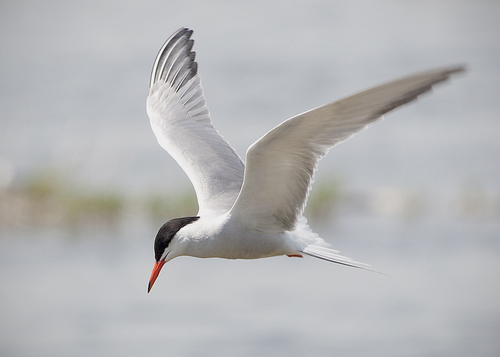
Common Tern
The Common Tern (Sterna hirundo) is a widespread seabird known for its graceful flight and long migrations. It plays a vital role in coastal and inland aquatic ecosystems, primarily as a predator of small fish and invertebrates. This species is often seen in large, noisy colonies during the breeding season, making it a conspicuous part of many wetland and coastal environments. While not currently globally threatened, it faces localized declines due to habitat loss and disturbance.
31-35 cm
Length
77-98 cm
Wingspan
Least Concern
Conservation Status
Distribution
The Common Tern has a wide distribution, breeding across North America, Europe, and Asia. It winters along coastlines in the Southern Hemisphere, including South America, Africa, and parts of southern Asia and Australia. It is a highly migratory species, with some populations undertaking extensive journeys.
Lifespan
The average lifespan in the wild is around 9 years, but individuals can live much longer, with records exceeding 20 years.
Common Tern's Habitat
Habitat Types
Coastal areas, Beaches, Estuaries, Salt marshes, Lakes, Rivers
Climate Zones
Temperate, Subtropical, Tropical
Adaptations
Common Terns are adapted to plunge-diving for fish. Their streamlined bodies and pointed wings allow for efficient flight and underwater pursuit. Their webbed feet aid in swimming.
Variations
Several subspecies are recognized, including *S. h. hirundo* (North America and Europe), *S. h. longipennis* (eastern Asia), and *S. h. minussensis* (central Asia). These differ subtly in size and plumage coloration.
Appearance
Breeding Plumage
Breeding adults have a black cap, pale grey upperparts, white underparts, and a red-orange bill with a black tip. Non-breeding adults have a white forehead and a black bill.
Seasonal Feather Changes
The black cap recedes in winter, leaving a white forehead and a black band behind the eye.
Sex Based Plumage Differences
Males and females have very similar plumage.
Notable Features
Forked tail, Black cap (in breeding plumage), Red-orange bill with a black tip (in breeding plumage)
Diet and Feeding
Primary Foods
Small fish, Crustaceans, Insects
Foraging Behavior
Common Terns primarily feed by plunge-diving, hovering over the water and then diving to catch prey near the surface. They may also dip down to the surface to snatch food while in flight.
Specializations
Their streamlined bodies and pointed wings are adaptations for efficient diving.
Seasonal Diet Variations
The diet can vary depending on location and prey availability. During the breeding season, they may focus on small fish, while at other times they may consume more crustaceans or insects.
Behavior
Social Structure
Common Terns are highly social, breeding in colonies that can range from a few pairs to thousands of birds. They are also often seen in flocks outside of the breeding season.
Communication
Vocalizations, including a characteristic 'kee-arr' call, Visual displays, such as postures and movements
Migration
Common Terns are long-distance migrants. Birds breeding in North America may winter as far south as South America, while European breeders may winter in Africa. They often follow coastlines during migration.
Territorial or Group Behaviors
They are highly territorial during the breeding season, aggressively defending their nest sites from intruders, including other terns and potential predators.
Conservation
Threats
Habitat loss and degradation, Disturbance at breeding colonies, Pollution, Climate change (affecting prey availability and nesting sites), Predation (by introduced species on breeding islands)
Protection Programs
Habitat restoration and protection, Management of human disturbance at breeding colonies, Monitoring of populations
Local National Laws
Protected under various national and international laws, including the Migratory Bird Treaty Act in the United States.
Population Trend
Stable
Population Estimates
The global population is estimated to be in the millions, but some regional populations are declining.
Interesting Facts
Common Terns are known for their aggressive defense of their nests.
They will dive-bomb and even strike intruders, including humans, that approach too closely.
They undertake some of the longest migrations of any tern species.
Some individuals travel thousands of kilometers between their breeding and wintering grounds.
They can sometimes be seen 'kleptoparasitizing' other birds.
This means they steal food from other birds, often chasing them until they drop their catch.
Faqs about Common Tern
How can I distinguish a Common Tern from other tern species?
Look for the combination of a black cap (in breeding plumage), a red-orange bill with a black tip, and a deeply forked tail. The Arctic Tern is very similar but has a shorter bill that is entirely red, and longer tail streamers.
Where can I see Common Terns?
Look for them along coastlines, estuaries, and large inland lakes, particularly during the breeding season. They are often seen near beaches and sandbars.
What do Common Tern chicks look like?
Chicks are downy and mottled brown and white, providing camouflage on the ground.
Are Common Terns endangered?
No, the global population is considered to be of Least Concern. However, local populations can be threatened by habitat loss and other factors.
Copyright @ Nature Style Limited. All Rights Reserved.
 English
English